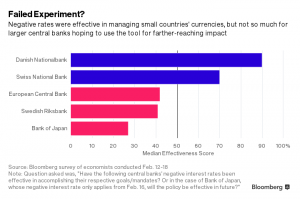On January 29th, Bank of Japan announced that they would lower their interest rate past the traditional 0% – into the negatives (-0.1% to be specific). I initially wrote this off as more Abenomics, but as I looked further into the concept I discovered that Bank of the Japan was not the only bank to adopt a negative interest rate. The US Federal Reserve had a near 0% interest rate for about a decade to encourage growth and take the edge off the 2008 recession. But what does a negative interest rate mean for banks? Bloomberg asked 63 economists, that focus on banks in the euro space, if negative interest rates have helped these five banks achieve their goals.
A majority of the economists were confident in the success of Danish Nationalbank and Swiss National Bank’s lowered interest rates, but less so in larger euro banks (Bank of Japan, European Central Bank and Swedish Riksbank). The economists didn’t believe that the larger banks using negative interest rates for “further reaching impact” (e.g. fiscal stimulus) would succeed, but the smaller banks utilizing it to manage their currencies seem to have applied the strategy successfully. Since Bank of Japan only recently lowered their interest rates into the negatives, the economists surveyed gave (pretty unforgiving) forecasts. If Bank of Japan wants to fight deflation and encourage Japan to start spending again, this might not be the best way to do it.

